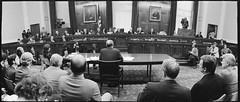Cheap proprietary software still costs too much.
 The following is part of an open letter I wrote to an university committee that was surveying students and faculty on the feasibility and desirability of providing discounts to students for popular and expensive software packages. This discount would have been provided by basically sharing the cost among all students by purchasing a large number of licenses and then reselling them at a lower price to interested students. Obviously, I thought there was a better alternative.
The following is part of an open letter I wrote to an university committee that was surveying students and faculty on the feasibility and desirability of providing discounts to students for popular and expensive software packages. This discount would have been provided by basically sharing the cost among all students by purchasing a large number of licenses and then reselling them at a lower price to interested students. Obviously, I thought there was a better alternative.
To Software License Group members:
I agree that it is a noble cause to provide students with access to software at a cost that is commensurate with the resources of the average university student. However, with full-priced office suites and programs running as much as $300 to $700, even discounted software can be prohibitively expensive for this university’s students who are most in need of the discount. In the interest of accessibility, this program should be expanded beyond simple discounts.
This committee should task itself with locating and increasing awareness of Open Source and Closed-source free software. Through the use of Open Source Software, the university will promote the continued development of programs that work independently of proprietary systems and encourage the development of software that does not require a discount to be use-able by the vast majority of students.
For nearly every proprietary software packages, there is a free alternative. The following list is just a small selection of the many open source and free applications that are equivalent if not superior to their closed-source, proprietary and often expensive counterparts.
Microsoft Office Suite (Word, Excel, PowerPoint, Access) -> OpenOffice.org
Photoshop -> TheGimp
Adobe Illustrator -> Inkscape
3D Studio Max -> Blender
There are many equivalent software packages, so the following site is one of many that may be of use to the Committee. http://www.osalt.com/
Many school districts, universities, businesses and even governments are switching to open source projects because not only do they save money, but often the open source applications are more secure because of their transparency.
I am a Linux user, so I do not specifically use most of the closed-source applications that the university promotes; however, I am able to design programs, write documents, and create movies as easily as any user of the proprietary systems. My .doc and .xls files created in OpenOffice.org (a platform independent program) transfer into Microsoft Word and Excel, but do not require that I spend what is for some, a weeks pay. All of my work, both academic and personal, is done with free and open-source software which is available for nearly every operating system.
I urge the committee to look beyond its admirable but basic goal and to work expand this university’s students ability to access the tools they need to succeed in their educational endeavors. It is our responsibility as employees of this university to encourage students to learn — regardless of whether they are learning quantum mechanics or a better program on which they may write an essay.
Sincerely,
Aaron Harun
fin